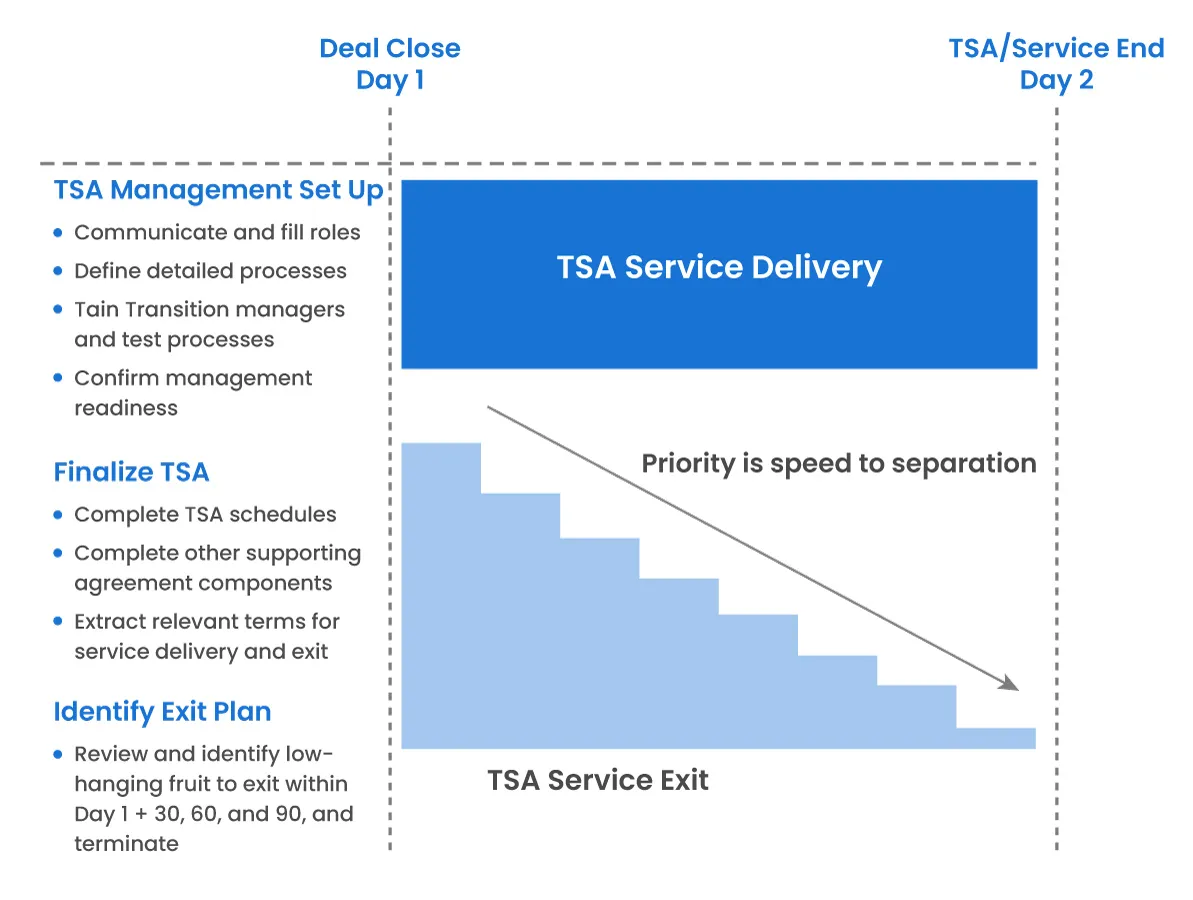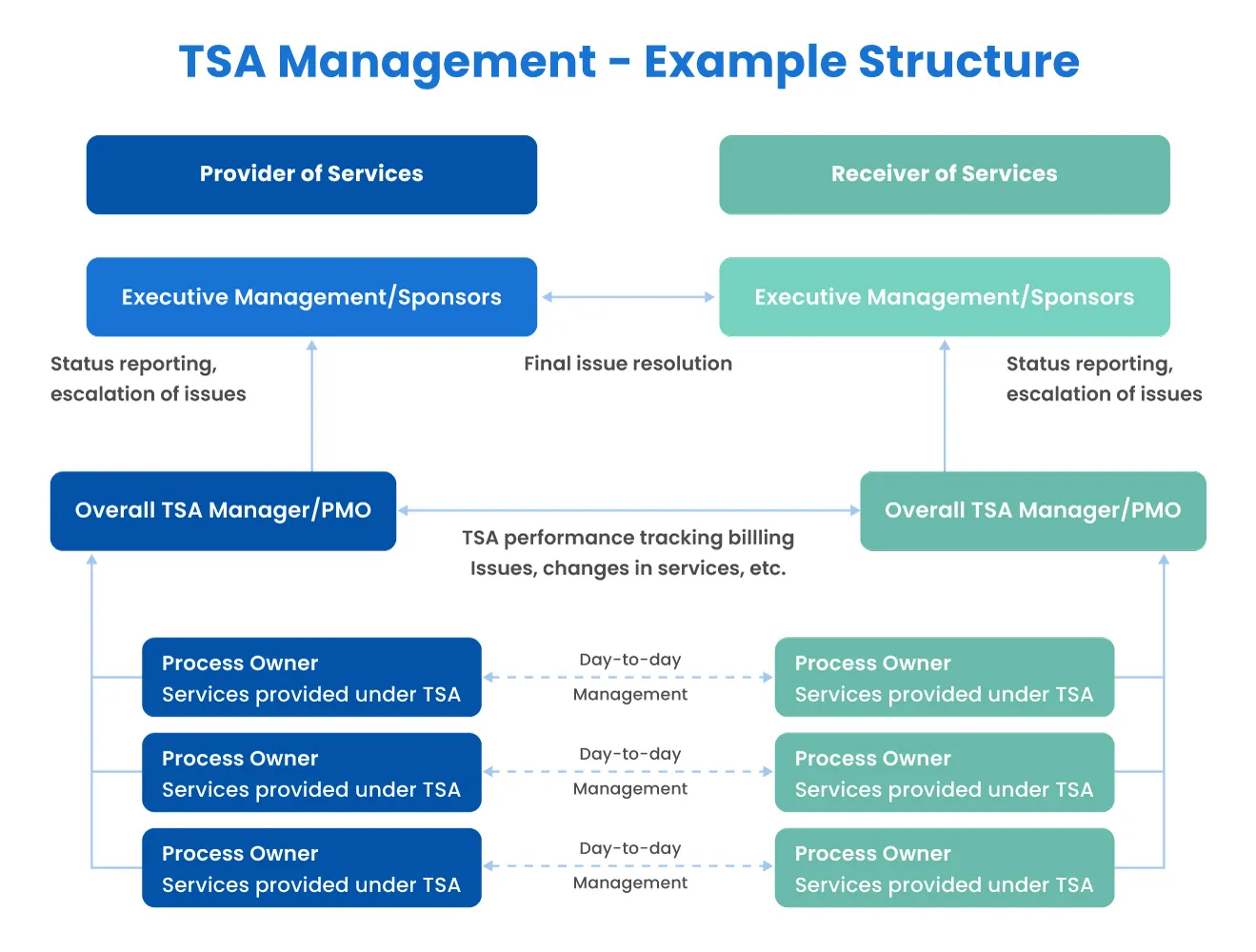The period in which a business unit or company is divested is fraught with risk for both sides of the transaction.
One of the means which has emerged to manage this risk is the Transition Service Agreement (TSA), a legal document which provides buyers and sellers with a framework for the gray area that exists between closing the deal and separating the businesses.
DealRoom help thousands of firms streamline processes around divestiture transactions and in this article, we look at TSAs and the role in divestitures TSAs play.
What is Transition Service Agreement?
A Transition Service Agreement (TSA) is an agrement between buyer and seller companies (or divested entities) in which one entity provides services and support (i.e., IT, finance, HR, real estate, payroll, etc.) to another after the closure of a divestiture to ensure business continuity. TSAs have become increasingly popular as companies’ technology stacks become larger, making disentangling business units far more complex than it once was.

Understanding Transition Service Agreements
Divestitures are rarely a case of identifying an underperforming asset, division or subsidiary and deciding to sell.
More often than not, each of these is far more integrated in the seller’s business than they’re aware. Several divisions are likely to share the same information technology, head office functions, and distribution. Customer contracts are also likely to be affected. Effectively carving out what needs to be sold can be complex and time consuming.
Negotiating this complexity begins at the due diligence phase, when companies determine the milestones that need to be negotiated for a smooth transition of ownership. Once these have been drawn up, they can be articulated in the Transition Service Agreement (TSA).
The TSA is a contract, usually involving some consideration, which outlines support services that the seller agrees to provide the buyer for a defined period of time after the transaction has closed.
When the broad terms of the TSA have been agreed between the seller and buyer, an estimation is made about the deadlines, costs, and cost drivers for fulfilling each of the tasks outlined therein.
Both sides need to be realistic here - overly ambitious TSAs have the potential to generate more problems than they solve. Both sides then need to engage fully with the process: A successfully managed transition period can generate value for both sides of the transaction.
Forward vs. Reverse TSA
A distinction is sometimes made between a forward and a reverse TSA; a forward TSA covers the provision of services from seller to buyer.
A reverse TSA, on the contrary, covers the provision of services from the buyer to the seller.
Although forward TSAs are far more common, anecdotal evidence suggests that reverse TSAs are also on the increase.
Benefits of Transition Service Agreements
.webp)
The benefits of transition service agreements are as follows:
- Smoother transition: TSAs essentially ensure that the small details in transactions which may once have been overlooked, are given due attention. This in turn leads to smoother transactions.
- Define what is being sold: Business units cannot be sold with ‘one leg in and one leg out.’ It has to be all or nothing. TSAs help managers to focus on this concept, drawing attention to issues that could later destroy value if not immediately addressed.
- Value generation: The clarity brought by TSAs generates value for both sides of the transaction. Ultimately, both sides want to return to operations as quickly as possible after the transaction and a TSA facilitates this.
- Reduced risk: As outlined at the beginning of this article, reducing risk is one of the principal aims of TSAs. Ensuring that the small details don’t become big details reduces the risk on both sides of the transaction.
Key Considerations for Drafting an Effective TSA

Among the issues that need to be considered when drafting a TSA include:
- Envision an end state: The seller (or buyer) needs to consider what the end state of the company should be after the transition period has wrapped. This will help when setting goals within the TSA.
- Budget accordingly: Remember that almost everything is a cost to the business to some extent: office space, executive time, and even casual Zoom calls between buyer and seller have a cost. Ensure that these are accounted for at the outset.
- Ensure contract clarity: ‘Project creep’ - the risk of projects moving outside their original intended scope - dogs many TSAs. by ensuring clarity in the TSA, this can be avoided and deadlines are more likely to be met.
- Collaborate: Whether you’re on the buy-side or the sell-side, collaborate with the other side. Everyone stands to create value from the TSA. Collaborating also enables the process to wrap up more efficiently.

TSA M&A Playbook/Template
When drafting a TSA playbook, our M&A Academy at M&A Science has already provided resources for companies going through a divestiture process and in need of TSA.
In summary:
- Define what services would be required to manage business continuity from day one.
- Check if the scope of services is appropriate.
- Define measurables and auditable service levels.
- Define the duration of services.
- Check for regulatory and compliance issues.
- Confirm for potential contractual issues with IT vendors.
- Prepare indicative costing of TSA services.
- Outline how governance would work post-close.
Get Your TSA Template Here.
Structure and Key Elements of TSAs

“No two carve-outs are alike. Templates are maybe 80% right—there’s always 20% white space you have to figure out.”
- Keith Crawford
Shared at The Buyer-Led M&A™ Summit (watch the entire summit for free here)
Frequently Asked Questions
What is a transition service agreement?
A transition service agreement, or TSA, is a short-term contract between a buyer and seller after a company sale. It allows the seller to keep running certain functions, such as IT or payroll, until the buyer can take them over.
Why is a TSA used in mergers and acquisitions?
A TSA keeps operations running while ownership changes. It gives the buyer time to build systems, hire staff, or move data without disrupting daily work.
What services are usually included in a TSA?
Common services include accounting, HR, IT support, and supply management. Let’s look: these are tasks that need to stay active during the handover period.
How long does a transition service agreement last?
Most last between three and twelve months, depending on deal size and how complex the business is. Some run longer if systems or regulations require extra setup time.
Who prepares a TSA?
The seller usually drafts the first version, and both sides review it. Legal and finance teams make sure each service, cost, and deadline is clearly defined.
What are the risks of a transition service agreement?
Risks include unclear pricing, missed deadlines, or too much reliance on the seller. Strong planning and regular progress checks keep these risks low.
How can companies manage a TSA effectively?
They set clear timelines, track costs closely, and assign a joint project lead. Here’s how it helps: this structure keeps both sides accountable and speeds up the handover.
Wrap up
All companies going through the divestiture process should make a transition service agreement a central part of the process.
As well as focusing managers’ and their employees on the gray areas likely to pose problems in the sale, a well drafted TSA also has the potential to generate considerable value for both buyer and seller.
Talk to DealRoom today about our expertise in TSAs and how they facilitate better divestitures.




















.png)
.webp)



.webp)
.webp)
.webp)





.png)
.png)
.png)
.svg)

.svg)
.png)
